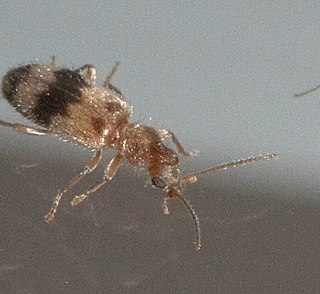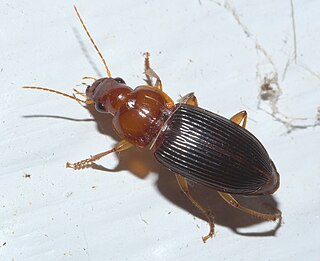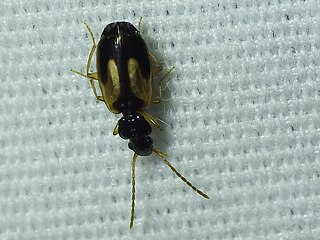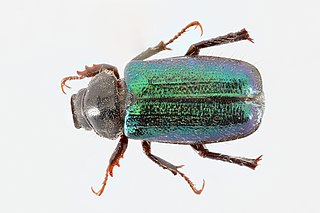
Hygrotus is a genus of beetle in family Dytiscidae. It contains two subgenera and about 70 species, including:

Gyrinus is a genus of small aquatic whirligig beetles in the family Gyrinidae native to the Palearctic, the Near East, the Nearctic, North Africa, Asia and Australia.

Notoxus is a large genus of beetles that resemble ants. It comprises about 300 species worldwide.

George Henry Horn was an American entomologist who specialized in the study of beetles.

Notiophilus is a genus of ground beetle native to the Palearctic, the Nearctic, the Near East and North Africa. Most known for their distinctive head shape and size-body ratio the genus is sometimes referred to as the springtail stalkers.

Badister is a genus of ground beetle in the family Carabidae native to North Africa, the Near East, and the Holarctic, including Europe.

Hydrochus is the only living genus of beetle in the family Hydrochidae, which belongs to the superfamily Hydrophiloidea, and was formerly treated as a subfamily of Hydrophilidae. Hydrochus includes about 180 species, which are found worldwide. The name "Hydrochus" has also been used for a fly genus in the family Dolichopodidae, but this is a junior subjective synonym of the genus Rhaphium.

Notiobia is a genus of ground beetles in the family Carabidae, comprising at least 100 species.

Lebiinae is a subfamily of ground beetles in the family Carabidae. There are more than 330 genera and 6,300 described species in Lebiinae, in 5 tribes.

Axinopalpus is a genus in the beetle family Carabidae, found in North, Central, and South America. There are about 15 described species in Axinopalpus.

Scaritinae is a worldwide subfamily of beetles in the family Carabidae, containing more than 2400 species in over 140 genera.

Corticarina is a genus of beetles in the family Latridiidae, containing the following species:

Berosus is a genus of beetles in the family Hydrophilidae, the water scavenger beetles. The genus contains 273 species. It is distributed worldwide.

Cercyon is a genus of water scavenger beetles in the family Hydrophilidae. There are at least 50 described species in Cercyon.

Dichelonyx is a genus of May beetles and junebugs in the family Scarabaeidae. There are at least 30 described species in Dichelonyx.
Amara latior is a species of seed-eating ground beetle in the family Carabidae. It is found in North America.
Xerosaprinus is a genus of clown beetles in the family Histeridae. There are more than 20 described species in Xerosaprinus.
Oxycrepis rectangula is a species of ground beetle in the family Carabidae. It is found in the United States.
Euspilotus is a genus of clown beetles in the family Histeridae. There are more than 80 described species in Euspilotus.













